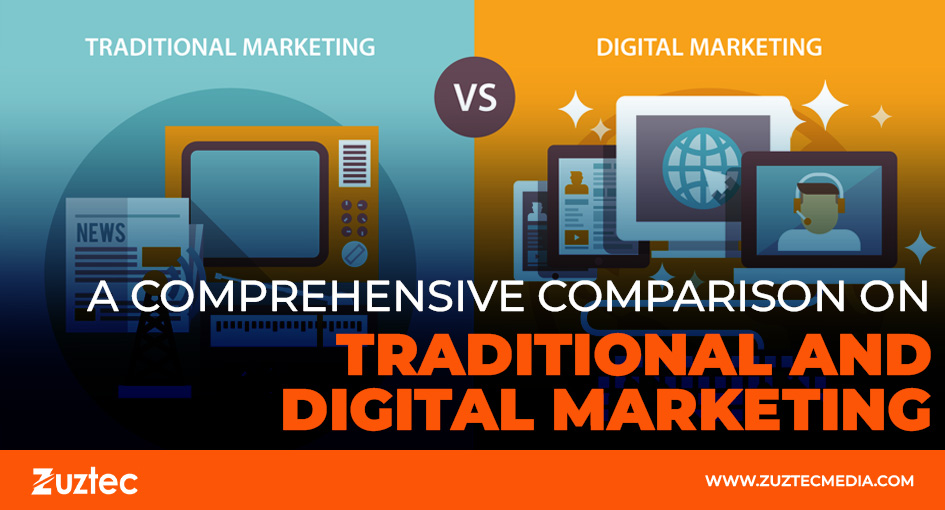
A Comprehensive Comparison on Traditional and Digital Marketing
Marketing has always been the cornerstone of business success, evolving with the changing dynamics of consumer behavior and technological advancements. Today, businesses have two primary avenues to promote their products and services: traditional and digital marketing. Both play significant roles in reaching target audiences, but they differ in approach, scope, and effectiveness. Understanding these differences is essential for creating a marketing strategy that aligns with your business goals.
Traditional marketing refers to conventional methods like print advertisements, television commercials, billboards, and direct mail. It has been a trusted form of outreach for decades and is still relevant for targeting local audiences and building brand recognition. On the other hand, digital marketing encompasses online strategies such as social media campaigns, email marketing, search engine optimization (SEO), and pay-per-click (PPC) advertising. It offers businesses the ability to connect with a global audience in real time while providing measurable results.
This article provides a comprehensive comparison of traditional and digital marketing, exploring their advantages, challenges, and how businesses can leverage both to maximize impact. Whether you’re a seasoned marketer or a business owner, understanding the interplay between these two marketing approaches is crucial for staying competitive in today’s dynamic marketplace.
Traditional and Digital Marketing: Traditional Marketing
Traditional marketing has been the backbone of promotional strategies for decades, characterized by its tangible and physical nature. Some key channels include:
- Print Media:
Newspapers, magazines, and brochures offer a physical form of advertising that appeals to specific demographics.
- Broadcast Media:
Television and radio commercials reach a broad audience, making them ideal for mass-market products.
- Outdoor Advertising:
Billboards and posters create high visibility in specific locations, ideal for local businesses.
- Direct Mail:
Flyers, postcards, and catalogs directly reach customers’ homes, creating a personal touch.
Advantages of Traditional Marketing:
- Tangible Connection: Physical materials create a lasting impression.
- Broad Reach: Television and radio can target large, diverse audiences.
- Credibility: Traditional ads are often viewed as more trustworthy due to their longstanding presence.
Challenges of Traditional Marketing:
- High Costs: Print and broadcast ads can be expensive to produce and distribute.
- Limited Tracking: Measuring the effectiveness of campaigns is challenging.
- Inflexibility: Once launched, campaigns are difficult to adjust.
Traditional and Digital Marketing: Digital Marketing
Digital marketing leverages the internet and technology to connect with audiences through various channels, including:
- Social Media:
Platforms like Facebook, Instagram, and LinkedIn allow businesses to engage with their audience in real time.
- Email Marketing:
Personalized emails nurture leads and maintain customer relationships.
- Search Engine Optimization (SEO):
Optimizing content to rank higher on search engines increases organic traffic.
- Pay-Per-Click (PPC) Advertising:
Ads displayed on search engines and social media platforms ensure visibility to the right audience.
Advantages of Digital Marketing:
- Cost-Effectiveness: Lower costs compared to traditional advertising.
- Measurable Results: Tools like Google Analytics provide detailed insights into campaign performance.
- Real-Time Adjustments: Campaigns can be tweaked instantly based on data.
- Global Reach: Access to a worldwide audience at the click of a button.
Challenges of Digital Marketing:
- Over-Saturation: The digital space is crowded, making it harder to stand out.
- Learning Curve: Understanding digital tools and platforms requires time and effort.
- Dependence on Technology: Reliance on internet connectivity and platforms poses risks.
Traditional vs. Digital Marketing: A Comparative Analysis
- Cost:
Traditional marketing often requires significant investment upfront, while digital marketing offers affordable options for businesses of all sizes.
- Reach:
Digital marketing provides global reach, whereas traditional methods are more localized.
- Measurability:
Digital campaigns can be tracked in real time, while traditional campaigns rely on indirect metrics like customer surveys.
- Engagement:
Social media and email marketing facilitate two-way communication, whereas traditional ads are generally one-sided.
- Flexibility:
Digital marketing allows for instant changes to campaigns, unlike traditional marketing, which is fixed once launched.
Combining Traditional and Digital Marketing
Rather than viewing traditional and digital marketing as competitors, businesses can integrate both to create a cohesive strategy. For instance:
- Event Promotions:
Use traditional flyers to advertise a local event while running social media campaigns for broader exposure.
- Brand Building:
Combine TV commercials with online video ads to strengthen brand presence.
- Customer Engagement:
Leverage direct mail for personal touches while using email marketing for follow-ups.
In conclusion, both traditional and digital marketing have unique strengths and challenges, and the choice between the two depends on your business goals, target audience, and budget. While traditional marketing excels in building trust and brand recognition, digital marketing offers unparalleled reach, flexibility, and data-driven insights.
By understanding the nuances of each approach and finding the right balance, businesses can create a comprehensive marketing strategy that drives growth and ensures long-term success. Whether you focus on tried-and-true traditional methods, innovative digital strategies, or a blend of both, the key lies in delivering value to your audience and adapting to the ever-changing landscape of marketing.

